12924
S30E49 Data 2022-01-04
Long Jupiter 75 area 30
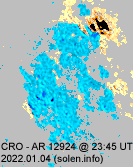 New region 12924 [S30E49] 30 emerged on January 3 and was numbered the next day by SWPC.
New region 12924 [S30E49] 30 emerged on January 3 and was numbered the next day by SWPC.report(past month only)
12924
S32E65 Data 2022-01-04
Long Jupiter 59 area 30
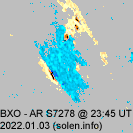 New region 12924 [S32E65] 30 emerged on January 3 as S7278 [S32E65]
New region 12924 [S32E65] 30 emerged on January 3 as S7278 [S32E65]report(past month only)
12924
S29E36 Data 2022-01-05
Long Jupiter 88 area 30
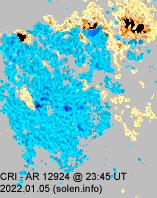 Region 12924 [S29E36] 30 was stable until after noon, then new flux began to emerge and several spots appeared.
Region 12924 [S29E36] 30 was stable until after noon, then new flux began to emerge and several spots appeared.report(past month only)
12924
S30E23 Data 2022-01-06
Long Jupiter 101 area 190
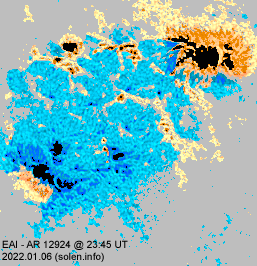 Region 12924 [S30E23] 190 developed quickly as more flux emerged. Even though the magnetic layout isn t very complex at this time, there is polarity intermixing and M class flares are possible. C1 flares: C1.1 @ 22:46 UT.
Region 12924 [S30E23] 190 developed quickly as more flux emerged. Even though the magnetic layout isn t very complex at this time, there is polarity intermixing and M class flares are possible. C1 flares: C1.1 @ 22:46 UT.report(past month only)
12924
S30E11 Data 2022-01-07
Long Jupiter 113 area 430
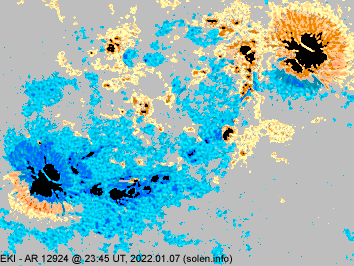 Region 12924 [S30E11] 430 developed further but remained mostly quiet. M class flares are possible. C1 flares: C1.1 @ 08:13 UT.
Region 12924 [S30E11] 430 developed further but remained mostly quiet. M class flares are possible. C1 flares: C1.1 @ 08:13 UT.report(past month only)
12924
S30W01 Data 2022-01-08
Long Jupiter 125 area 430
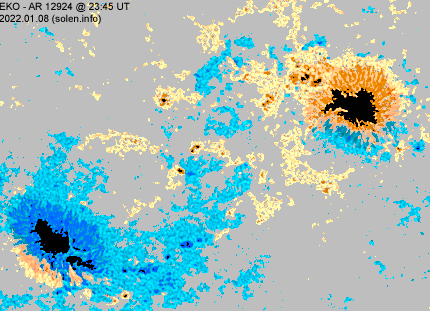 Region 12924 [S30W01] 430 decayed slowly losing a few spots. The region currently has a fairly simple magnetic layout, however, there is a chance of an M class flare.
Region 12924 [S30W01] 430 decayed slowly losing a few spots. The region currently has a fairly simple magnetic layout, however, there is a chance of an M class flare.report(past month only)
12924
S30W01 Data 2022-01-09
Long Jupiter 130 area 380
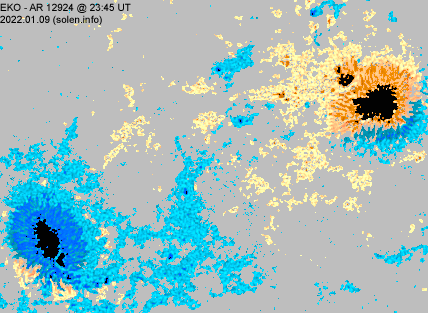 Region 12924 [S30W01] 380 decayed further and lost many tiny spots.
Region 12924 [S30W01] 380 decayed further and lost many tiny spots.report(past month only)
12924
S31W27 Data 2022-01-10
Long Jupiter 157 area 350
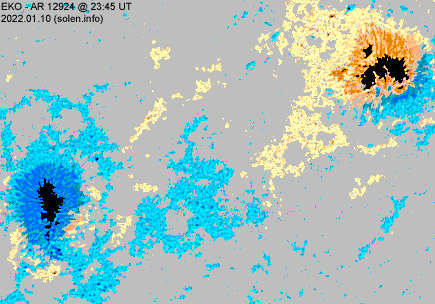 Region 12924 [S31W27] 350 decayed slowly and quietly.
Region 12924 [S31W27] 350 decayed slowly and quietly.report(past month only)
12924
S31W39 Data 2022-01-11
Long Jupiter 170 area 350
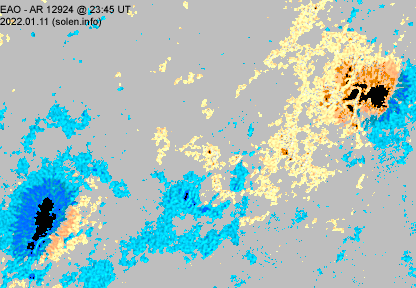 Region 12924 [S31W39] 350 decayed slowly and quietly.
Region 12924 [S31W39] 350 decayed slowly and quietly.report(past month only)
12924
S31W50 Data 2022-01-12
Long Jupiter -179 area 370
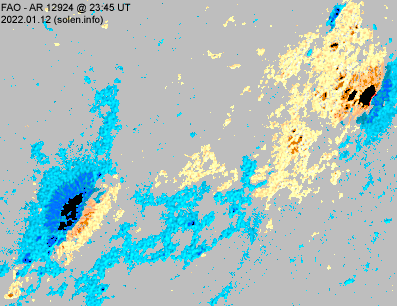 Region 12924 [S31W50] 370 lost area, however, some small spots emerged and the region has minor polarity intermixing.
Region 12924 [S31W50] 370 lost area, however, some small spots emerged and the region has minor polarity intermixing.report(past month only)
12924
S31W64 Data 2022-01-13
Long Jupiter -163 area 390
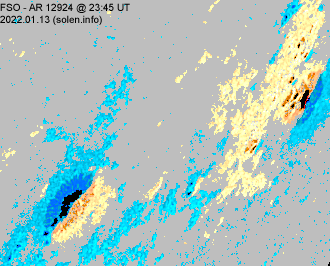 Region 12924 [S31W64] 390 decayed slowly and was mostly quiet.
Region 12924 [S31W64] 390 decayed slowly and was mostly quiet.report(past month only)
12924
S31W75 Data 2022-01-14
Long Jupiter -151 area 220
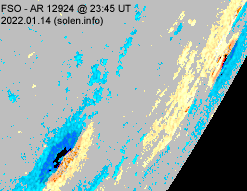 Region 12924 [S31W75] 220 decayed slowly and was mostly quiet.
Region 12924 [S31W75] 220 decayed slowly and was mostly quiet.report(past month only)
12924
S33W81 Data 2022-01-15
Long Jupiter -144 area 180
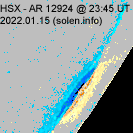 Region 12924 [S33W81] 180 rotated partly out of view. C1 flares: C1.3 @ 18:37 UT.
Region 12924 [S33W81] 180 rotated partly out of view. C1 flares: C1.3 @ 18:37 UT.report(past month only)